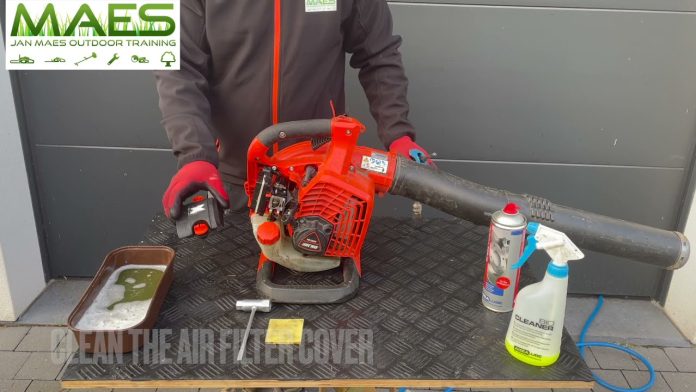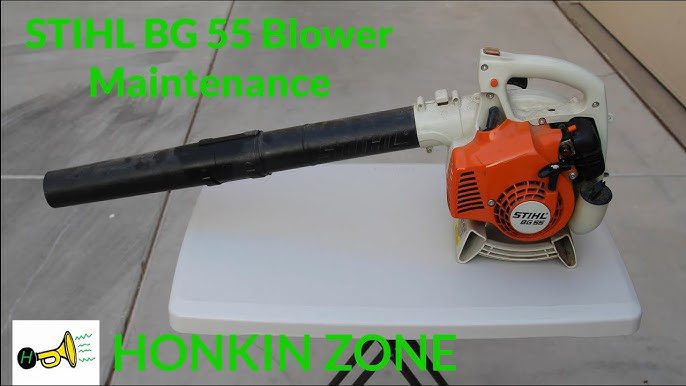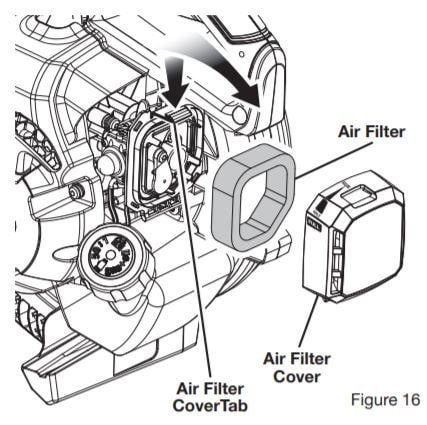Cleaning a leaf blower air filter may seem like a daunting task, but fear not! We’re here to guide you through the process in the friendliest and simplest way possible. In this article, we will share an easy step-by-step method to help you keep your leaf blower performing at its best. Say goodbye to clogged filters and hello to smooth operation! So, without further ado, let’s dive into the world of leaf blower air filter cleaning!
This image is property of i.ytimg.com.
Removing the Air Filter
Locating the air filter
When it comes to cleaning a leaf blower air filter, the first step is to locate the filter. The air filter can usually be found inside the housing of the leaf blower, near the engine. It may be secured with screws or latches depending on the make and model of your leaf blower. If you’re having trouble finding the air filter, consult the user manual for your specific leaf blower.
Turning off the leaf blower
Before attempting to remove the air filter, it is crucial to turn off the leaf blower and disconnect it from any power source. This step is necessary to ensure your safety while working on the leaf blower. Always remember to prioritize your well-being and take the necessary precautions when handling any machinery or equipment.
Opening the housing
Once the leaf blower is safely turned off and disconnected, it’s time to open the housing to gain access to the air filter. Depending on the leaf blower model, you may need a screwdriver or simply release the latches to remove the housing. Take your time and be gentle when handling the housing to avoid causing any damage.
Removing the filter
With the housing open, you can now remove the air filter from the leaf blower. Carefully lift the filter out of the housing, making sure not to drop or damage it in the process. Take a moment to observe the condition of the filter and identify any visible dirt, debris, or signs of damage.
Inspecting the Air Filter
Examining the filter for dirt and debris
After removing the air filter from the leaf blower, it’s important to inspect it for any dirt or debris accumulation. These foreign particles can clog the filter and affect its performance. Gently tap the filter to loosen any loose debris, and visually inspect the surface for dirt and grime.
Checking for damage or tears
In addition to dirt and debris, it’s essential to check the air filter for any signs of damage, such as tears or holes. A damaged filter may not effectively filter the air, compromising the performance of your leaf blower. Carefully examine the entire surface of the filter, paying close attention to the edges where tears are more likely to occur.
Cleaning the Air Filter
Using compressed air
One of the easiest and most effective ways to clean a leaf blower air filter is by using compressed air. With the air filter held over a garbage bin or outdoors, use a can of compressed air to blow away the dirt and debris. Make sure to angle the airflow in the opposite direction of the normal flow to ensure a thorough clean.
Tapping or shaking off loose debris
If compressed air is not available, you can also tap or shake the air filter to dislodge loose debris. Hold the filter over a garbage bin or a designated cleaning area and gently tap or shake it to remove the dirt. Repeat this process until no more debris falls off the filter.
Washing with soap and water
For filters that are heavily soiled or greasy, washing with soap and water can be an effective cleaning method. Fill a basin or sink with lukewarm water and add a mild dish soap. Place the air filter in the soapy water and gently agitate it to loosen dirt and grime. Allow the filter to soak for a few minutes before rinsing it thoroughly with clean water.
Soaking in a cleaning solution
In some cases, a cleaning solution specifically designed for air filters may be recommended. These solutions are formulated to effectively remove dirt, grease, and other contaminants. Follow the manufacturer’s instructions for the specific cleaning solution you choose, as the process may vary. Soak the air filter in the solution for the recommended duration, then thoroughly rinse it with clean water.
Using a vacuum cleaner
If you have a vacuum cleaner with a brush attachment, you can use it to clean the air filter. Gently run the brush over the surface of the filter, effectively removing any loose dirt or debris. Be cautious not to apply too much pressure or scrub vigorously, as this can damage the filter.
Drying the Air Filter
Allowing the filter to air dry
Once the air filter has been cleaned, it is crucial to ensure it is completely dry before reinstalling it. The simplest method to achieve this is by allowing the filter to air dry naturally. Find a well-ventilated area and place the filter on a clean, dry surface. Leave it undisturbed until it is completely dry to the touch.
Using a hairdryer or compressed air to speed up drying
If you’re in a hurry and need to speed up the drying process, you can use a hairdryer on a low or cool setting. Hold the hairdryer several inches away from the filter and move it back and forth to evenly distribute the airflow. Alternatively, you can use compressed air to blow-dry the filter. Remember to use caution and avoid using excessive heat, as it can damage the filter.
This image is property of i.ytimg.com.
Reinstalling the Air Filter
Inspecting the filter housing
Before reinstalling the air filter, take a moment to inspect the filter housing. Ensure that it is clean and free from any debris or residue. Wipe it down with a clean, dry cloth if necessary. This step helps to maintain the cleanliness of the newly cleaned air filter and ensures optimal performance.
Placing the filter back into the housing
With the filter housing prepared, carefully place the cleaned and dry air filter back into its original position. Ensure that it fits snugly and securely. Pay attention to any alignment marks or notches that indicate the correct orientation of the filter.
Closing and securing the housing
Once the air filter is correctly positioned, proceed to close and secure the housing. Make sure all latches or screws are properly fastened to prevent any air leaks. A secure housing will help maintain the efficiency and performance of your leaf blower.
Replacing the Air Filter
Determining when to replace the filter
While regular cleaning can prolong the lifespan of an air filter, there may come a time when it needs to be replaced entirely. Signs that a replacement is needed include severe damage, excessive wear and tear, or when the filter no longer effectively filters the air. Refer to the manufacturer’s guidelines or consult the user manual to determine the recommended replacement interval for your specific leaf blower.
Choosing the right replacement filter
When selecting a replacement air filter for your leaf blower, it is important to choose the appropriate one. Ensure that the replacement filter matches the make and model of your leaf blower to guarantee compatibility and optimal performance. If unsure, consult the manufacturer or refer to the user manual for guidance.
Installing the new filter
Installing a new air filter is a straightforward process. Simply follow the reverse steps of removing the filter. Open the housing, remove the old filter (if present), and carefully insert the new filter into its designated position. Ensure proper alignment and snug fit, then secure the housing to complete the installation.
This image is property of i.ytimg.com.
Regular Maintenance
Creating a cleaning schedule
To maintain optimal performance and prolong the life of your leaf blower, it is essential to establish a regular cleaning schedule for the air filter. The frequency of cleaning will depend on factors such as frequency of use, operating conditions, and the type of debris encountered. As a general guideline, it is recommended to inspect and clean the air filter every 10-15 hours of use.
Keeping the filter clean for optimal performance
Regular cleaning of the air filter is key to maintaining the overall performance of your leaf blower. By keeping the filter clean, you ensure that air can flow freely, preventing clogs and maintaining proper combustion. This, in turn, helps to optimize fuel efficiency and prolong the life of the engine.
Tips and Precautions
Wearing protective gloves and eyewear
When working with a leaf blower and handling the air filter, it is advisable to wear protective gloves and eyewear. This will protect your hands from any sharp edges or debris that may be present, as well as safeguard your eyes from potential particles during the cleaning process.
Using the manufacturer’s instructions as a guide
Always refer to the manufacturer’s instructions or user manual for specific guidance on cleaning and maintaining your leaf blower’s air filter. Each leaf blower model may have unique requirements, so following the manufacturer’s recommendations will ensure you are properly caring for your equipment.
Working in a well-ventilated area
Whether you are cleaning, inspecting, or installing the air filter, it is important to work in a well-ventilated area. This will help disperse any fumes or airborne particles, ensuring a safer and more comfortable working environment.
Avoiding damaging the filter during cleaning
When cleaning the air filter, be mindful of applying too much force or using harsh chemicals that may damage the filter material. Take care to follow the recommended cleaning methods and techniques to maintain the filter’s integrity and maximize its lifespan.
This image is property of www.leafblowersdirect.com.
Frequently Asked Questions
How often should I clean the air filter?
The frequency of cleaning the air filter depends on various factors such as usage, operating conditions, and the type of debris encountered. As a general guideline, inspecting and cleaning the air filter every 10-15 hours of use is recommended. However, it’s always advisable to refer to the manufacturer’s guidelines for your specific leaf blower model.
Can I wash the air filter with soap?
Yes, washing the air filter with soap can be an effective cleaning method for heavily soiled filters. Fill a basin or sink with lukewarm water and add a mild dish soap. Gently agitate the filter to loosen dirt and grime, then rinse it thoroughly with clean water. Allow the filter to air dry completely before reinstalling it.
Can I use a leaf blower to clean the filter?
While it may be tempting to use a leaf blower to clean the air filter, it is generally not recommended. Leaf blowers produce a high volume of air at a high velocity, which can potentially damage the filter or force debris deeper into the filter material. It is best to use alternative methods such as tapping, shaking, or using compressed air for a safer and more effective cleaning process.
What should I do if my air filter is damaged?
If your air filter is damaged, it is crucial to replace it promptly. A damaged filter may compromise the performance and efficiency of your leaf blower. Refer to the manufacturer’s guidelines or consult the user manual to determine the appropriate replacement filter for your specific leaf blower model.
Conclusion
Cleaning and maintaining your leaf blower’s air filter is a straightforward process that ensures optimal performance and extends the life of your equipment. By following the steps outlined in this article, you can effectively remove, inspect, clean, and reinstall the air filter. Remember to establish a regular cleaning schedule, choose the right replacement filter when necessary, and always prioritize your safety by following the manufacturer’s instructions and wearing protective gear. Proper care and maintenance of your leaf blower’s air filter will contribute to a longer-lasting, more efficient machine, allowing you to tackle your outdoor tasks with ease.
This image is property of www.growgardener.com.








































